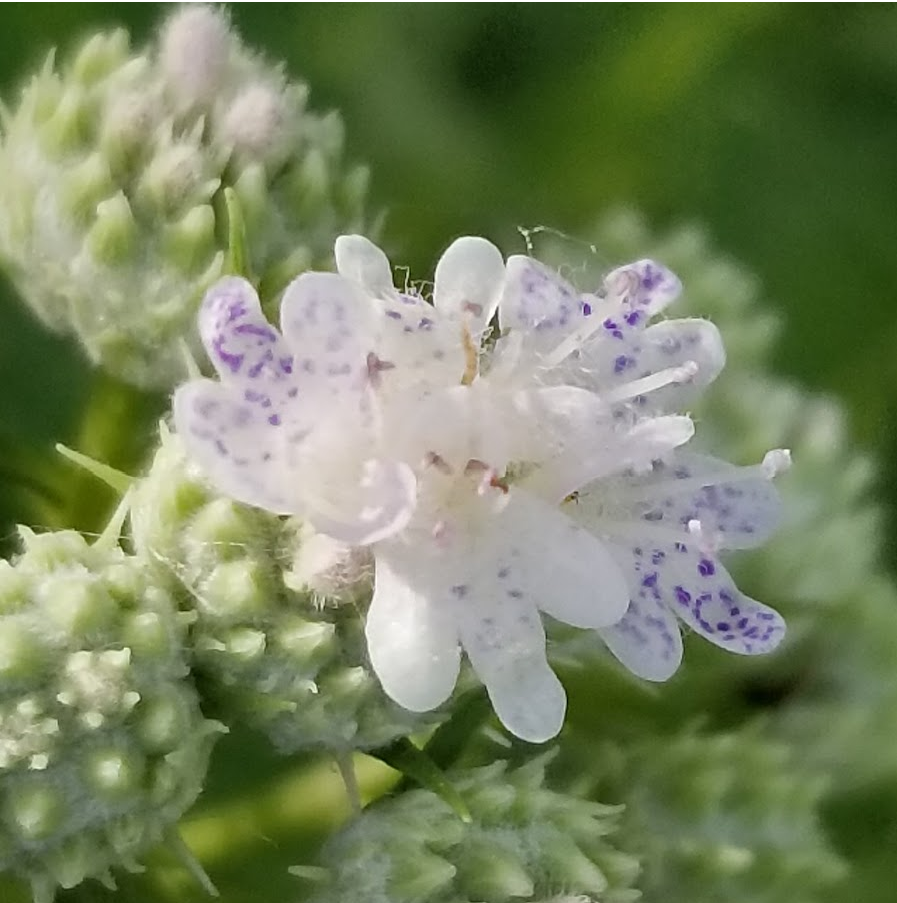Mountain mints are our July Plant of the Month. One of my favorite natives for the landscape, mountain mints are a slow-spreading, non-invasive member of the mint family. I first became acquainted with it after moving to Northeast Kansas, and I found slender mountain mint (P. tenuifolium) goring in a ditch by the Hiawatha, KS golf course. At the time I knew nothing about these wonderful plants.
There are around 20 species of mountain mints in North America. Here in the Central Great Plains, there are 3 somewhat common species. And we can grow species from other areas of the country. I have 3 species in my gardens personally. I have always been impressed with its tidiness, and the amount of pollinators which flock to it. And it smells a tastes similar to spearmint, which is my favorite for making tea.
Common Species of Mountain Mints for the Garden
If you are looking for a multi-purpose native for the garden, look no further. Mountain mints (Pycnanthemum species) are slow to spread, easy to maintain, attract lots of pollinators, and are edible. I will describe the 3 species I have in my garden, and a couple others which do well in the Central Great Plains and Midwestern regions.
Slender Mountain Mint – P. tenuifolium
Not only first species that I learned about, it was also the first one to be added to my garden. Before my Entry Garden became too shaded for it, I had it growing right by the entrance to the walk. After that, I had to move it to the meadow garden in the back. About 3 miles from my house is a small prairie remnant, about half an acre in size, where slender mountain mint grows.
It can be found throughout the eastern half of the US, from the eastern Great Plains to the Atlantic seaboard. It grows in glades, prairies, meadows, and more. The leaves of slender mountain mint are linear and smooth, free of hairs, or very slightly pubescent (hairy). It grows 2 to 3 feet tall, and slowly spreading. One of the clumps in my garden grew to 4 feet wide.

Virginia Mountain Mint – P. virginianum
I first found this mountain mint during a wildflower walk at Klinefelter Farm by Hiawatha, KS. Luckily, I had a good friend of mine who is a plant expert, even on natives in Nebraska and South Dakota, as well as Kansas. He discovered it first, growing by the edge of small farm pond. We also discovered another rare plant, a type of mustard rarely seen in Northeast Kansas. But the mint was the best thing,
Virginia mountain mint grows on the edge of lakes, rives, ponds, and streams, or in ditches. It prefers to be moist, and have its roots by water. I added it to my garden in 2019 and have been very happy with its ability to take dry conditions as well as wet. It grows 2 to 3 feet tall and is slowly spreading. The native range is the Upper Midwest region and scattered in the Northern Great Plains, from Kansas up.
Blunt Mountain Mint – P. muticum
This variety is not native in the Central Great Plains, but is can be found just outside of our range, in Arkansas and Missouri. Also, it can be found scattered around the Eastern half of the US. Unfortunately, this species is less drought tolerant than many of the other mountain mints. I added it to my Sunny Cottage Garden in 2021, and put it where there is a leak in the hose that I use to water my animals. That hose runs daily in spring, summer, and fall. And the blunt mountain mint responded by growing 4 feet tall and bloomed all summer long, even in intense heat.

Hairy Mountain Mint – P. verticillatum
This species of mountain mints can be found in the Central Great Plains and eastward to New England. It looks similar to slender mountain mint, but the leaves and stems are covered in fine hairs. I have not yet found it in my hiking, but I hope each year to come across new plants, so I will keep looking. I think that I will have to add it to my garden anyways.
Hairy mountain mint grows 2 to 4 feet tall and is slowly spreading like the rest of the mountain mints. I would expect to find it along rocky slopes, in glades or prairies, or along railroad banks, according to Mike Haddock, a friend of mine and the author of several books on native plants in Kansas.
Hoary Mountain Mint – P. incanum
The last species I will mention, this one is very similar in size and habit to blunt mountain mint. The main differences being that it can withstand drought much better, and that the flowers are sometimes tinged with lavender or purple. Hoary mountain mint grows 2 to 4 feet tall and is slowly spreading. Its native range is the eastern third of the US.
Pollinators and Pests of Mountain Mints
While pests of mountain mints are few, a handful of moths do utilize them as host plants. The mint borer moth, mint loving pyrausta moth, golden pyrausta moth, and the dimorphic gray moth all use members of the mint family, including mountain mints, as host plants. But they have no other pest problems, not being a plant eaten by herbivores like deer or rabbits.
Pollinators
There is a wide variety of insects which feed on the nectar and pollen of mountain mints, pollinating them at the same time. I have observed wasps, bees, beetles, butterflies, moths, and flies all on the flowers which bloom from June to September, depending on location and species.

Companion Plants of Mountain Mints
Putting mountain mints in the garden is easier than you would think. Many of our native plants do not do so well in garden settings, either being to vigorous with less root competition, or being too leggy. But mountain mints fit in well in a Cottage Garden, meadow, butterfly garden, monarch waystation, and more. Pick the best species for your different area and garden style.
Plants that go well with the mountain mints include species which complement their blooms and bloom times.
- Native grasses including switchgrass, little bluestem, blue grama, and sideoats grama
- Purple prairie clover
- Leadplant
- Butterfly milkweed
- Yarrow
- Greyhead coneflower
- Monarda
- Lambs Ears
- Lavender
- Penstemon
- Purple coneflower
Conclusion
Mountain mints are great perennial natives for the garden, because they do not spread and take over, they attract a lot of pollinators, and they are edible. Adding them to your garden will improve biodiversity, add pollinator prowess, and allow for a better stand against the manipulated climate.
Happy planting!





I enjoyed reading your information about the mints. I know I have some in the seeds planted in my pollinator garden. I just have to recognize what is what. But, I do need some advice please, if you will. At least half of my pollinator garden has a good stand of crabgrass along with the good plants that I want to keep. I am thinking that maybe after a frost the crabgrass will die back and be easier for me to just pull it. Do you think that is a good idea??
Also, I should leave the wildflowers stand all winter, correct??? Then should I clean up in the spring and if so, when??
I am so excited about this garden and just want to do the right things. Thank you for your help!!!
Hi Peggy, nice to hear from you. I find that the easiest way to remove larger crabgrass is by cutting it off below the soil with a soil knife. Or you can wait until after frost (October!) and pull it, but the seeds for next season will have already scattered. I recommend leaving plants for pollinators stand all winter, and cutting back in spring when daytime temps are consistently in the 50s. This gives overwintering pollinators a chance to wake up and come out of stems or the soil/leaf litter. Do not worry about doing it perfectly right, we are all learning things as we go, there are many different ways to do things.
Happy planting!
Andrew Mitchell
One more question. Is there a pre-emergent for crabgrass only??? For the spring seeds.
Hi Peggy,
There are several products on the market for preventing the germination of crabgrass. However, I must caution use of it in plots where you might be seeding in annuals, vegetables, or perennials, as it will prevent these from germinating as well. Products containing Dimension or Prodiamine are best for preventing crabgrass from sprouting. It is best applied in March, before the soil warms up and the crabgrass seeds sprout.
Happy planting!
Andrew Mitchell